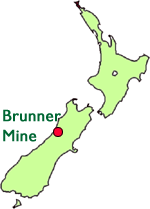
Brunner Mine
Encyclopedia

West Coast, New Zealand
The West Coast is one of the administrative regions of New Zealand, located on the west coast of the South Island, and is one of the more remote and most sparsely populated areas of the country. It is made up of three districts: Buller, Grey and Westland...
of the South Island in New Zealand
New Zealand
New Zealand is an island country in the south-western Pacific Ocean comprising two main landmasses and numerous smaller islands. The country is situated some east of Australia across the Tasman Sea, and roughly south of the Pacific island nations of New Caledonia, Fiji, and Tonga...
.
The Brunner Mine was one of several mines situated on the banks of the Grey River
Grey River
The Grey River / Māwheranui is located in the northwest of the South Island of New Zealand. It rises in Lake Christabel, one of numerous small lakes on the western side of the Southern Alps,12 kilometres southwest of the Lewis Pass, and runs westward for 120 kilometres before draining into the...
, at an area known as "Coal Gorge" between the townships of Stillwater and Taylorville. The town of Brunner
Brunner, New Zealand
Brunner is a town in the northwest of New Zealand's South Island. Together with Taylorville and Dobson to the south-west, it had a population of 672 at the 2006 census. It is 12 kilometres to the east of Greymouth, on the south bank of the Grey River. It is on the Midland Line railway near its...
(formerly Brunnerton) is nearby.
Coal was discovered on the West Coast by Nelson surveyor Thomas Brunner
Thomas Brunner
Thomas Brunner was an English-born surveyor and explorer remembered for his exploration of the western coastal areas of New Zealand's South Island....
"during the most arduous of his journeys in search of more agricultural land". The coal was of extremely high quality and it did not take long before it attracted interest. And, of course, "The West Coast had the added attraction of gold mining and it seems that the employment opportunity offered by coal mining was in the difficult economic times not one to be turned down".
Brunner Mine disaster
In March 1896 an explosion deep in the mine killed all 65 miners inside, and was labelled the worst mining disaster in New Zealand’s history. It seemed most likely that the explosion was caused by firedampFiredamp
Firedamp is a flammable gas found in coal mines. It is the name given to a number of flammable gases, especially methane. It is particularly commonly found in areas where the coal is bituminous...
, a common hazard in coal mines, where a pocket of methane gas is accidentally ignited and explodes.
Current site
Today all that visibly remains of the mine and its related industry are the remains of the old coke ovens on the north side of the river, as well as the memorial at that location listing the names of the miners killed. Not to mention the graves in Stillwater cemetery, including one mass grave containing the bodies of 33 of the miners killed. The entrance to the mine has long been engulfed by the bush, as have any trace of the bustling industry that once existed on that spot. The chimney on the south bank between the road and railway line has often been associated with the Brunner Mine, but was actually part of the Tyneside MineTyneside Mine
The Tyneside Mine was a coal mine on the West Coast of the South Island in New Zealand.-External links:* - Tyneside Mine...
on the south side of the river.
External links
- Historic Brunner Mine at the Department of Conservation
- Brunner Mine Industrial Site at the Historic Places Trust

